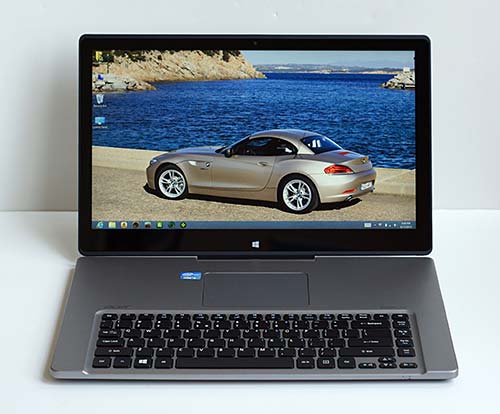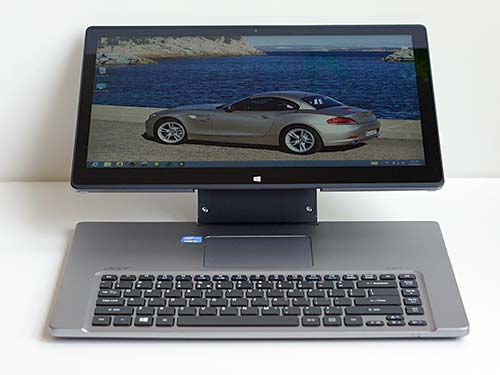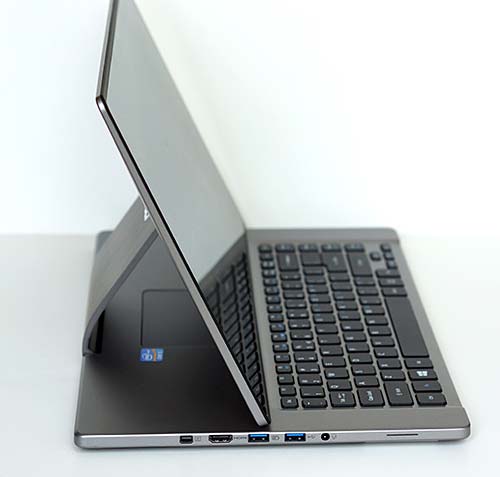Acer Aspire R7 Review
08:35
Acer
has been doing very interesting things with their Windows 8 machines,
and the Acer Aspire R7 is their boldest product to date. The Aspire R7
would look at home on the set of Star Trek, as Acer pointed out in their
marketing videos with a Star Trek movie spin. At first blush it's a
15.6" slim and light laptop with an odd but attractive lid design
element. That design element is actually a very robust yet stylish
looking center hinge, and this Windows 8 convertible transforms from
laptop to tablet, to presentation mode and a variety of positions in
between. It even has what we like to call a "lazy Susan" or "tray table"
position where the display floats parallel to the table and keyboard
for closer access. If you thought the Lenovo Yoga 13 was cool and innovative, the Acer Aspire R7 makes it look a little staid.

Specs: What's Inside
Inside we've got standard Ultrabook
components, though this machine is by no means an Ultrabook in terms of
size and weight. The 5.3 lb. R7 runs on a 1.8GHz Intel Core i5-3337U CPU
(that's the recently refresh Ivy Bridge Core i5 from Intel). It has
Intel HD 4000 graphics, 6 gigs of DDR3 RAM, a 500 gig (5400 rpm) hard
drive and a 24 gig caching SSD to speed up boot and application load
times. It has Broadcom dual band WiFi (no WiDi), Bluetooth 4.0 +HS and a
720p webcam. There's no dedicated graphics option here in the US. The
machine runs Windows 8 64 bit on the same internals as other Ultrabooks
on the market, and that means it's more than capable of handling MS
Office, photo editing, light video editing, web browsing, email and
social networking. It has all the ingredients to be a main laptop unless
you're a serious gamer, heavy duty number cruncher or professional CAD
designer (though some CAD users make do with ULV CPUs and integrated
graphics).

Design and Ergonomics
For $999, the Acer Aspire R7 feels and
looks like a quality piece (Acer is no longer the company that makes
cheap netbooks). The patented hinge is brilliantly simple with none of
the trap doors or slightly exposed wires that we noted on the Sony Vaio Duo 11
and Toshiba Satellite U925t convertible Ultrabooks. The hinge's brushed
metal back is attractive and strong. Acer calls it their Ezel hinge (a
pun on easel + easy) and it's surprisingly firm, yet it doesn't require
herculean effort to move. You can use it in any position and it won't
wobble, shift or fall prey to gravity. Likewise it doesn't bounce when
you touch it with a finger. We've seen good, dubious and simply mediocre
convertible designs on Windows 8 convertibles, and I'd call this one a
winner. It's useful, not overly complex and attractive. The casing is
made of a mix of plastic and aluminum, and it has a high quality look.
The bottom cover has a black soft touch coating that feels great and is
easy to grip. The display panel doesn't have significant flex and all
seams are well mated.

The drawbacks? The trackpad is oddly
placed behind the backlit keyboard, so you have to reach across the
keyboard to use it. Acer's is counting on you using the touch screen
instead of the trackpad. Since the Aspire R7 has a position that moves
the display to cover the trackpad while bringing it closer to the
keyboard, it mostly works for us. Ignoring the placement issue, the
trackpad is passable but not one of the best we've used on Windows 8
convertibles.
The 5.3 lb. laptop isn't exactly an
ultraportable, but Acer intends it to be a home or work PC that goes
from room to room rather than a road warrior. It has three USB ports (2
USB 3.0 on the left and one USB 2.0 on the right), a full size HDMI
port, 3.5mm combo audio and an SDXC card slot. It does not have a wired
Ethernet port, so you'll have to buy a USB Ethernet adapter if needed.
There's a proprietary "Acer Converter Port" that looks like a mini
DisplayPort or Thunderbolt port but isn't (I tested it with a
Thunderbolt monitor and Ethernet adapter). Acer states that they'll make
adapters for display, Ethernet and USB for this port, but they're not
available as of this writing.
Display and Multimedia
The star of the show, once you
look past the versatile design, is the full HD IPS 1920 x 1080 gloss
display with 10 points of multi-touch. It has wide viewing angles and
clarity, and colors are vibrant. It's a really bright, sweet looking
display, and that's perfect for this multimedia-centric convertible.
Though glossy like most all touch screens, reflections aren't
overbearing and text is viewable at 100% font scaling on the Windows
desktop UI. HD movies look lovely with good blacks, rich colors and no
motion blur. Text is crisp and it's a huge step up from lower resolution
TN panel laptops.
Acer places two large speakers
with Dolby Home Theatre v4 on the bottom, and they're loud enough for a
family to gather 'round to enjoy a movie together. Bass won't tickle
your teeth, but it's not tinny or harsh either. Very nice.
Performance and Horsepower

The Acer Aspire R7 runs on the
updated Ivy Bridge Intel Core-i5 3317U 1.8 GHz CPU with Turbo Boost to
2.7GHz. This is a ULV (ultra low voltage) CPU that's more commonly found
in Ultrabooks and it's more than capable of handling 1080p video
playback, MS Office work, web browsers with several tabs open, photo
editing and even HD video editing. The R7 ships with 6 gigs of RAM for
the initial release US model, and it has 4 gigs of RAM soldered on the
motherboard and one standard SODIMM RAM slot with a 2 gig DDR3 RAM
module installed. RAM speeds were surprisingly good, reaching dual
channel speeds.
The machine has a 24 gig caching
mSATA SSD (ours is Kingston brand) that speeds up boot times and
Windows. It's not accessible as a drive letter for program
installations. The 500 gig HDD is your C drive (ours is a Toshiba 5400
RPM drive), and it's a standard low profile 2.5" SATA drive similar to
those used on other slim notebooks. That means it's fairly easy to find
an upgrade part if you wish to move to an SSD drive, a higher capacity
drive or a faster 7200 RPM drive. The Aspire R7 boots quickly, launches
apps fairly quickly and feels very responsive thanks to the caching SSD.
The caching SSD plus a capacious HDD is a good combo here, offering
both responsiveness and lots of storage. It doesn't benchmark as well as
machines with 100% solid-state storage, but it feels quick enough.
So far in the US, the Aspire R7
is available only with Intel HD 4000 integrated graphics. We've heard
that there are dedicated graphics versions popping up overseas for a
considerable price premium. For non-hardcore gamers, the HD 4000 is more
than adequate and it can handle light 3D gaming with more forgiving
current titles at low settings and resolutions. But this is by no means a
serious gaming rig.
Accessing the Internals: Upgradable Parts Inside
If you want to access the single
RAM slot, standard 2.5" SATA hard drive bay, mSATA SSD and wireless
card, you'll need to remove 10 visible Torx screws and three additional
Torx screws that are hidden under the two rubber strips that run across
the bottom (not under the rubber feet). These strips are affixed with
double sided adhesive tape: be careful not to tear it up when you pull
the strips off or you'll have to go shopping for very thin double sided
sticky tape.
One you've removed the bottom
cover, the machine is quite upgradable. You can upgrade to 8 or 12 gigs
of RAM by removing the single 2 gig DDR3 1600MHz RAM module and
replacing it with a 4 or 8 gig DIMM. The 2.5" SATA drive bay will
accommodate standard thin profile SSD and HDDs. Nice. You could also
upgrade the mSATA caching drive, but that would likely require more
fiddling in Windows 8 since the mSATA drive is set up as a caching
rather than main drive.
Keyboard
Though low travel, the Aspire
R7's keyboard was surprisingly efficient and the island style keys are
touch typist friendly. It feels a little weird not having a wrist rest
area on the keyboard deck, but we managed fine when typing with the
laptop on a desk. The backlight is lovely: the letters light up and
there's a gentle white ring of light around each key.
Battery Life and Heat
Thanks to the ULV CPU, the Acer
Aspire R7 runs cool and quiet. The fan rarely got loud and the R7 was
never hot to the touch. It ships with a fairly compact charger, and
since it uses Ultrabook internals, it doesn't require a big charger or
huge battery. That said, it's no Energizer bunny, and we averaged 4.5 to
4.75 hours of use on a charge with brightness set to a very adequate
50% and WiFi on. The 4 cell, 3560 mAh Lithium Ion battery isn't
particularly high capacity and the 15.6" full HD display is power
hungry, so don't expect 6 hour Ultrabook runtimes here.
|


0 comments